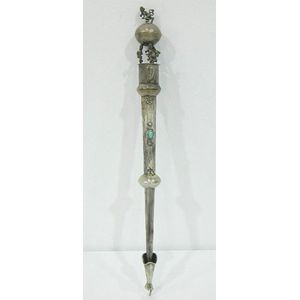Regency Rosewood Breakfront Side Cabinet with Grilled Doors
You must be a subscriber, and be logged in to view price and dealer details.
Subscribe Now to view actual auction price for this item
When you subscribe, you have the option of setting the currency in which to display prices to $Au, $US, $NZ or Stg.
- Breakfront - A design generally found in larger pieces of furniture, such as bookcases, wardrobes and some sideboards. The line of the front is interrupted by the middle section standing out from each end. In a reverse breakfront, the centre section is recessed behind each end. Breakfronted pieces are usually made in three sections the middle and the two wings which are held together by the cornice and pediment, and the plinth on which it stands. The sensible buyer should show caution before buying breakfront pieces, especially bookcases, which are highly desirable and expensive. Always check that the timber, colour, patination, backboards, decoration and thickness of the wood are same in each section.
- Pilasters - In furniture a pilaster is a flattened column-like detail
applied to furniture. It is similar to a pilaster in architecture, but it is
typically smaller and less ornate. Pilasters are often used to decorate the
fronts of bookcases, cabinets, and other pieces of furniture. Pilasters can be
made of wood, metal, or other materials. They can be fluted, carved, or plain.
Pilasters are often used to add a touch of elegance and sophistication to
furniture. - Reeding - A series of parallel, raised convex mouldings or bands, in section resembling a series of the letter 'm'. The opposite form of fluting, with which it is sometimes combined. Reeding is commonly found on chair legs, either turned or straight, on the arms and backs of chairs and couches and around table edges in the Neoclassical or Classical Revival manner. Reeding was also used as a form of decoration during the Edwardian period, but it is usually much shallower and evidently machine made.
- Frieze - An architectural term denoting the flat, shaped or convex horizontal surface of furniture, between the architrave and the cornice, usually found on a cabinet or bookcase, or on desks and tables where it may include drawers, the area between the top and the legs. In ceramics, the term refers to the banding, of usually a repeating pattern, on the rims of plates and vases.
- Rosewood - A dense timber that varies in shade to very light brown to almost black. When rosewood is cut and sanded the colour of the timber will turn black, and after polishing and exposure to daylight, the surface will gradually lighten over time to light brown with black streaks.
The name comes from the odour emanating from the timber when it is planed, sanded or cut.
Rosewood was very popular for use in Victorian furniture in the second half of the 19th century, and at that time most of the rosewood was imported from Brazil. However it also grows in India and Indonesia.
It is used in the sold for chairs and table legs, but for carcase furniture such as side cabinets and bookcases, and for table tops it is always used as a veneer. - Bun Feet - Similar to ball feet, though somewhat compressed or flattened in appearance. Introduced during the late 17th century, but they have been used on furniture up to the present day.
- Regency Period - The Regency period in English furniture design refers to the period when King George III, was declared unfit to rule in 1811, and his son ruled as proxy as Prince Regent, until 1820, and then, after the death of his father as George IV until his death in 1830. The Regency period was preceded by the Georgian period (George I, George II, and George III: 1714 - 1811), and was followed by the William IV period, which only lasted until 1837 when William IV died as was succeeded by Queen Victoria.
This item has been included into following indexes:
Visually similar items

A large pair of Japanese bronze dragon and phoenix decorated floor vases, 102 cm high

Georg Jensen (1866 -1935) A pair of sterling silver candle holders hallmarked and numbered 263 total weight of silver 730grs, 15 cm high

A Russian silver torah pointer, engraved with a Hebrew inscription to front two panels, the hand terminal decorated with fluted cuff, the pierced work rampant lion terminal supported by a winged eagle, Russian hallmarks 84 fineness, dated 1863, 31 cm, Wt 7

A Continental carved oak armchair early 20th century the chair is extensively carved with figures and lions in the Jacobean style height 135 cm
